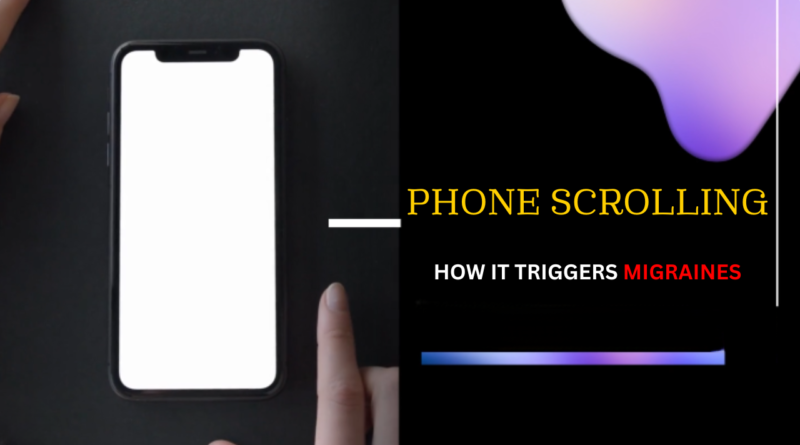Phone Scrolling | How It Triggers Migraines
In today’s digital age, phone scrolling has become a habitual activity for millions of people. Whether checking social media, reading the news, or playing games, the time spent on screens is increasing. However, this seemingly harmless activity can have unintended health consequences, one of the most concerning being migraines. But how exactly does scrolling on your phone trigger migraines, and what can you do to prevent them? Let’s dive into this topic.
The Connection Between Phone Scrolling and Migraines:
Migraines are severe headaches often accompanied by symptoms such as nausea, sensitivity to light, and visual disturbances. Although genetics and other medical factors contribute to migraines, lifestyle choices, like excessive phone use, can also play a role.
Why Phone Scrolling Can Cause Migraines:
Blue Light Exposure:
Blue light from modern smartphones is a stressor to your eyes and will disturb your sleep. Overstimulation may result in headaches, and eventually, migraines when scrolling late at night.
Eye Strain:
Focusing on a small screen causes the muscles around your eyes to work much harder. In time, this leads to digital eye strain, a common migraine trigger.
Poor Posture:
Many people use their heads as a cramp to scroll, placing strain on neck and shoulder muscles. This posture balance is referred to as “tech neck,” a condition that contributes to tension headaches and migraines.
Flickering Screens:
Unstable refresh rates or flickering screens stimulate the brain, creating an increased predisposition to migrate, especially for visually sensitive individuals.
Sensory Overload:
Constant notifications and bright visuals flood the brain with so much information, that it can contribute to stress migraines.
How to Know If Scrolling on Your Phone Is Causing Migraines:
Migraines from phone use usually have some warning signs:
- A dull headache that worsens with prolonged scrolling.
- Pain that worsens with exposure to bright screens.
- Sensitivity to light and noise while using your phone.
- Nausea or dizziness that coincides with screen use.
If you experience these symptoms, limiting your screen time and changing your habits is essential.
Top Hacks to Prevent Phone-Triggered Migraines:
While it’s almost impossible to stop using phones, the following will lower your chances of experiencing migraines:
1. Blue Light Filters:
Use blue light filters for your phone, or get yourself some blue light-blocking glasses. This will ease the strain on your eyes and also improve the quality of sleep.
2. Break Time:
Use the 20-20-20 rule: Look at something 20 feet away for 20 seconds every 20 minutes.
3. Maintain Proper Posture:
Hold your phone at eye level to avoid straining your neck and shoulders.
4. Adjust Screen Settings:
Lower your screen brightness and increase the text size to reduce visual strain.
5. Limit Notifications:
Turn off unnecessary alerts to minimize sensory overload and interruptions.
6. Set Screen Time Limits:
Use apps that track and limit your phone usage. Aim for quality over quantity when it comes to screen time.
Foods That Can Help Reduce Migraines:
Add the following foods to your diet and you may help ward off those phone-scrolling-induced migraines.
Magnesium-Rich Foods:
Spinach, almonds, avocado. These help relax blood vessels and ease the pain of headaches.
Omega-3 Fatty Acids:
These healthy fats in salmon and flaxseeds reduce inflammation, a migraine trigger.
Hydration Boosters:
Cucumbers and watermelon are among the foods that keep you hydrated because dehydration often exacerbates migraines.
Ginger:
This natural anti-inflammatory may help ease nausea and reduce migraine severity.
Long-Term Consequences of Not Solving the Problem:
If you keep scrolling through your feeds without solving the problem, you risk:
- Chronic migraines that are harder to treat.
- Deteriorating eye health, with a risk of macular degeneration.
- Mental fatigue and decreased productivity.
You can save both your short-term and long-term health by taking action now.
Conclusion:
Phone scrolling has become an integral part of modern life, but it’s important to recognize its potential health impacts. From blue light exposure to poor posture, several factors can trigger migraines. By implementing practical solutions, like taking breaks, adjusting screen settings, and eating a migraine-friendly diet, you can continue using your phone without compromising your health.
Be mindful of your screen time and listen to your body. If migraines persist, consult a healthcare professional for tailored advice. Small changes today can make a big difference tomorrow.
FAQs:
1. Can phone screens alone cause migraines?
No, but they can be a trigger for those prone to migraines due to factors like blue light, eye strain, and poor posture.
2. How much phone use is safe to avoid migraines?
It’s best to limit screen time to 2–3 hours a day for leisure activities and take frequent breaks.
3. Are migraines from phone scrolling reversible?
Yes, with lifestyle adjustments like reducing screen time, using filters, and improving posture, you can reduce the frequency of migraines.
4. Do blue light glasses help with migraines?
Yes, they can minimize the effects of blue light, reducing the likelihood of migraines.
5. What are the best apps to manage screen time?
Apps like Digital Wellbeing (Android) and Screen Time (iOS) help track and limit usage.
6. Can migraines from phone scrolling affect sleep?
Yes, blue light disrupts melatonin production, leading to poor sleep and increased migraine risk.
